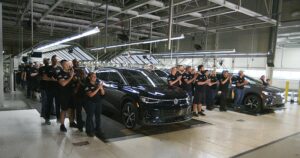This month, we’re discussing the Supreme Court’s elimination of Chevron deference and what it means for climate regulation, the multiple significant milestones the advanced nuclear sector has achieved, and the new joint venture between Volkswagen and Rivian.
Deference Deferred
The Supreme Court got rid of Chevron deference in a recent court case, which essentially deferred to the executive branch agencies on the specifics of regulatory interpretation when laws were ambiguous (which they often are). This is likely to have a major impact on environmental and climate regulation, especially in the short term.
Ironically, the idea of Chevron deference originally protected the loosening of environmental standards during the Regan administration.
I am not a lawyer, but this seems a bit silly to me. Having worked in an agency in the executive branch, attempting to implement an initiative passed into law, I can attest to the many vagaries that exist in laws trying to create new initiatives and capabilities. Many pieces of legislation have areas of ambiguity – and this is not necessarily a bad thing – the folks passing the legislation need to know the purpose and impact of the laws they are passing, but are unlikely to be experts in the specifics of specific policy minutiae (so they often put something in there that says ‘make sure this rule is in the public interest’ – essentially as far away from getting specific as possible).
That said, it’s not like this eliminates all environmental regulation – in passing the Inflation Reduction Act, Congress actually expanded the Environmental Protection Agency’s regulatory authority in anticipation of this Chevron deference standard being eliminated by the court. And this ruling doesn’t get rid of the agency’s regulatory authority overall, but it does open up the specific regulatory actions to more challenges.
Over the long term, Congress will adjust by creating more specificity in legislation, but there’s likely to be a significant amount of legal challenge and upheaval over the next few years. This upheaval and uncertainty will be particularly impactful for emerging climate solutions whose economics are improved by or require regulation to be viable – these folks are likely to have more trouble attracting investors and partners given the increased uncertainty.
Going Nuclear
 Credit: GatesNotes
Credit: GatesNotes
Oppenheimer may have come out last summer, but this summer has even more atomic action so far.
The advanced nuclear startup backed by Bill Gates, TerraPower, conducted a groundbreaking for its first plant in Wyoming. It’ll be under construction for years, but is still a significant achievement as it is the first advanced reactor to (in this case a 345 mw reactor using sodium sodium instead of water, with a molten salt energy storage system that makes it a better fit for the variability of renewable power on the grid).
Also this month, Congress passed the ADVANCE Act which aims to streamline the permitting process for advanced reactors. While advanced nuclear developers are taking a variety of new technological approaches, it is really the regulatory permitting process that is the most substantial obstacle to deploying new advanced systems – folks see fixing the permitting as the key to unlocking the new technological approaches (because it is such a significant driver of cost).
Rivian & Volkswagen
 Credit: Times Free Press
Credit: Times Free Press
We mentioned Rivian last month; this month the company is back in the news with the announcement of a $5 billion joint venture with Volkswagen. This is a big news item for the electric vehicle industry. There’s a marriage here that makes sense: Rivian can bring its EV component supply chain and software expertise; Volkwagen can contribute its substantial balance sheet.
With the transition to electric vehicles, software and component integration become more important. In the past, the windshield pipers and the engine and the motor that rolls up the windows were all part of the same vehicles, but weren’t necessarily integrated (and didn’t really need to be). If you’re designing from scratch though, it makes sense to have all of your components tied into the same system, speaking the same language. Hence significant investments in software development capabilities.
Other News
Elemental Excelerator released an analysis on the size of the capital gap for climate technology scale up.
EIA shared data showing how electrolyzers are a small portion of hydrogen production today, but growing significantly (hat tip Future of Transportation)
A recent analysis finds that the vast majority of funding from the Inflation Reduction Act (passed with only Democratic support is flowing to GOP districts. Although politically amusing, this makes intuitive sense since most renewable development is in rural areas, typically represented by Republicans.
Although it is being impacted by tariff decisions, the US Solar industry is expected to have a huge year, partially because companies stocked up on imported equipment before the tariff deadline.
NHTSA finalized new fuel economy standards for vehicles.
Developers continue to look at the Midwest as prime location for data centers to meet new computing demand.